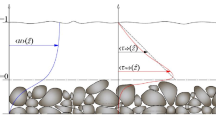Abstract
Mixing layers are sensitive to the mixing angle and turbulence in the primary streams. Although there is extensive available research on this rather basic flow, there are still no suggestions for a clearly best configuration. For example, the combination of a laminar initial boundary layer and a large mixing angle has received little attention. In this work we test a new experimental configuration with large mixing angle and laminar/turbulent initial boundary layer that was not examined experimentally by LDA and PIV. This setup is expected to be a representation of the initial conditions that must result in better mixing. A plane mixing layer with a velocity ratio of 0.6 is produced by rebuilding an open circuit wind tunnel. Extensive calibration tests on velocity profiles and Reynolds stresses established the position of the self similar region. Velocity field measurements with laser Doppler anemometer (LDA) and particle image velocimeter (PIV) showed enhanced mixing layer growth. PIV plots showed the presence of stream-wise and cross stream vortices in the self-similar region without any considerable change in turbulence characteristics to that of reported in the literature. The article presents a combination of different experimental results that give a deeper understanding of this very configuration.
Similar content being viewed by others
References
E. Balaras, U. Piomelli and J. M. Wallace, Self-similar states in turbulent mixing layers, J. Fluid Mechanics, 446 (2001) 1–24.
J. H. Bell and R. D. Mehta, Measurements of the streamwise vertical structures in a plane mixing layer, J. FuidMechanics, 239 (1992) 213–248.
J. H. Bell and R. D. Mehta, Development of a two-stream mixing layer from tripped and untripped boundary layers, AIAA journal, 28(12) (1990) 2034–2041.
K. C. Wiecek and R. D. Mehta, Effects of velocity ratio on mixing layer three-dimensionality, Experimental thermal and fluid science, 16 (1998) 165–176.
M. AbdulAzim and A. K. M. Sadrul Islam, Plane mixing layer from parallel and non-parallel merging of two streams, Experiments in Fluids, 34 (2003) 220–226.
H. Shlichting, Boundary-layer theory. Chapter XVII, McGraw-Hill Book Company (1968).
M. Mehrjooei, Investigation of plane mixing layer by using PIV. M.Sc. thesis, Amirkabir University of Technology, Tehran, Iran (2009).
M. G. Olsen and J. C. Dutton, Stochastic estimation of large structure in an incompressible mixing layer, AIAA journal, 40(12) (2002) 2431–2438.
G. Akbari, N. Montazerin and M. Akbarizadeh, Stereoscopic particle image velocimetry of the flow field in the rotor exit region of a forward-blade centrifugal turbo machine, Proceedings of the Institution of Mechanical Engineers, Part A, Journal of Power and Energy, 226(2) (2012) 163–181.
D. A. Johnson, D. Modarress and F. K. Owen, An experimental verification of laser-velocimetersampling bias and its correction. Trans. ASME, J. FluidsEng, 106 (1984) 5–12.
A. K. Prasad and R. J. Adrian, Stereoscopic particle image velocimetry applied to liquid flows, Exp. Fluids, 15 (1993) 49–60.
Flow manager software and introduction to PIV instrumentation. Tonbakken 16–18 DK-2740 Skovlunde Denmark, dantec Dynamics A/S (2002).
R. D. Keane and R. J. Adrian, Optimization of particle image velocimeters. Part 1: Double pulsed systems, Meas. Sci. Technology, (1990) 1:1202–1215.
Yi-Chih Chow, PIV measurements of flow structure and turbulent in rotor wake within a multi-stage turbo machine, PhD thesis, John Hopkins University (2005).
S. B. Pope, Turbulent flows, Cambridge University Press (2000).
A. A. Townsend, Structure of turbulent shear flow, Cambridge Univ. Press, Cambridge, England (1976) 188–230.
R. J. Adrian, K. T. Christensen and Z. C. Liu, Analysis and interpretation of instantaneous turbulent velocity fields, Experiments in fluids, 29 (2000) 275–290.
P. Druault, J. Delville and J. Bonnet, Experimental 3D analysis of the large scale behavior of a plane turbulent mixing layer, Flow Turbulence and Combustion, 74 (2005) 207–233.
AGARD-AR-345 Report: A selection of test cases for the validation of large eddy simulations of turbulent flows, (1998).
R. D. Mehta, Effect of velocity ratio on plane mixing layer development: Influence of the splitter plate wake, Exp. Fluids, 10 (1991) 194–204.
D. Oster and L. Wygnanski, The forced mixing layer between parallel streams, J. Fluid mech. 123 (1982) 91–130.
L. Perret, J. Delville, R. Manceau and J. Bonnet, Generation of turbulent inflow condition for large eddy simulation from stereoscopic PIV measurements, Int. J. of Heat and Fluid Flow, 27 (2006) 576–584.
R. Escudie and L. Alian, Analysis of turbulence anisotropy in a mixing tank, Chemical Engineering Science, 61 (2006) 2771–2779.
Author information
Authors and Affiliations
Corresponding author
Additional information
Recommended by Associate Editor Simon Song
MojtabaMehrjooei received his Bachelor’s degree from the University of Tabriz and MSc degree from Amirkabir University of Technology. His research interests include experimental fluid mechanics and development of gas refineries. He works with gas refinery companies.
Nader Montazerin is professor of Mechanical Engineering at Amirkabir University of Technology. He received his Bachelor’s degree fromSharif University of Technology, Tehran, Iran. This was followed by MSc and Ph.D degrees in Mechanical Engineering from Cranfield University, Bedford, England. His research interests include turbomachines, experimental fluid mechanics, natural gas distribution systems and applied energy systems. He has done various consultancy works with natural gas and power industries.
Abraham Damangir is Emeritus assistant professor in Mechanical Engineering at Amirkabir University of Technology. He received his BSc. and Ph.D from the same university but earned his MSc from the Imperial College of Science and Technology, England.
Rights and permissions
About this article
Cite this article
Mehrjooei, M., Montazerin, N. & Damangir, A. Laser velocimetry of a plane mixing layer with a specific initial condition for study of turbulence characteristics of enhanced growth rate. J Mech Sci Technol 26, 1049–1057 (2012). https://doi.org/10.1007/s12206-012-0222-0
Received:
Revised:
Accepted:
Published:
Issue Date:
DOI: https://doi.org/10.1007/s12206-012-0222-0




